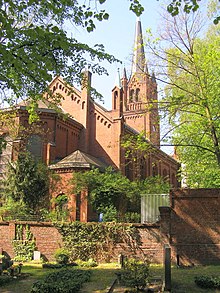Magdalenenkirche (Berlin-Neukölln)

The Magdalenenkirche was built from 1877 to 1879 by Wendt and Hermann Bohl in the arched style. The nave church has a polygonal choir and a square tower. In World War II the church, apart from the windows was only very slight damage it. The Magdalenenkirche is located in the Berlin district of Neukölln , Karl-Marx-Straße 201, and is a listed building .
history
The old village church on Richardplatz in Rixdorf had long since become too small for the Sunday service, so a replacement building was considered. A building site was available on the Rixdorf cemetery, which was laid out in 1819, and was no longer needed. But negotiations had to take a long time before the foundation stone for the new church was laid on July 12, 1877. The church was consecrated on March 25, 1879. In 1910 the church was rebuilt and provided with new heating and electrical lighting. In 1928 a new steel bell replaced the bells delivered in 1917. In 1929 the interior was renewed. After the Second World War, the church was thoroughly renovated. On November 8, 1959, it was again handed over to the community, which only became independent on April 1, 1948, previously it had belonged to the Neukölln town church. In the years 1984–1986 the church was restored again.
Building
With its basilical style, the church follows the expiring tradition of the builders Schinkel , Stüler and Adler . The masonry, faced with red bricks, was laid out in an east-west direction. The facade is structured by pilaster strips , cornices and round arch friezes. The entrance side on what was then Bergstrasse was given a high tower, the octagonal helmet of which is flanked by four smaller corner turrets. The top floor of the tower is open in two gabled arcades . The choir was with 5 / 8 -Schluss formed. In 1969 a chapel for prayer was added to the church .
Interior
The nave was given a visible wooden roof structure. The galleries are also made of wood. The sanctuary is vaulted. The color scheme was based on classicist models. In 1910 a new table-shaped altar made from Swabian shell limestone replaced the previous one. The oldest evidence in the church is the crucifix on the altar, which had stood in the old village church until 1879. It comes from the 16./17. Century. The dark oak imitation with multicolored decorative elements dates from 1910. The parapet fields of the gallery were painted dark in 1929. The current ocher paint on the nave corresponds to the original color scheme from 1879. The picture of Martin Luther next to the entrance was painted in 1883 by Ernst Moritz Geyger . Another painting shows Mary Magdalene meeting the risen Jesus Christ .
In 1959 the interior of the church was repainted. The lighting also dates from that time. Finally, in the 1970s, the floor had to be replaced. A seating took the place of the old church pews , to utilize the church also for other than liturgical purposes. During the last restoration, the original painting was exposed in some places. The capitals and carvings were gilded, the chancel and the side walls were given an olive green panel. The baptismal font commemorates the destruction of the Second World War. It was made from part of a chapter of the Kaiser Wilhelm Memorial Church , which was destroyed in the war .
organ
The organ in the Magdalenenkirche no longer meets the requirements for church music and concert events. Therefore the organ has to be restored. The instrument dates from 1879, the year the church was built, and was built by the most important organ building workshop in Berlin at the time, the Ferdinand Dinse company . In 1909 the organ was supplemented by the Sauer company . The registers were rebuilt. Numerous organ pipes were stolen during the two world wars . Each of these companies shaped the sound of the instrument in the respective epoch, whereby the originally romantic overall sound was lost. Instruments from the organ building companies Dinse and Sauer are, however, worthy of protection as cultural heritage. The experts advise returning the organ to its original condition from 1879 (Dinse) or 1909 (Sauer). The restoration is carried out by the companies Mitteldeutscher Orgelbau A. Voigt and Christian Scheffler .
|
|
|
||||||||||||||||||||||||||||||||||||||||||||||||||||||||||||||||||||||||||||||||||||||||||||||||||||||||||||||||||||||||||||||||||||||||||
- Coupling: II / I (also as sub and super octave coupling) II / II (super octave coupling), I / P, II / P
literature
- Architects and Engineers Association of Berlin: Berlin and its buildings. Part VI. Sacred buildings. Berlin 1997.
- Günther Kühne, Elisabeth Stephani: Evangelical churches in Berlin. Berlin 1978.
- Georg Dehio : Handbook of the German art monuments. Band Berlin. Munich / Berlin 2006.
Web links
Individual evidence
Coordinates: 52 ° 28 ′ 19.8 ″ N , 13 ° 26 ′ 30 ″ E
